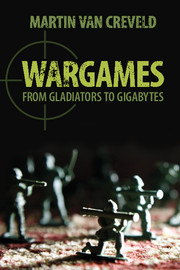Book contents
- Frontmatter
- Contents
- Acknowledgments
- Introduction
- 1 On animals and men
- 2 Games and gladiators
- 3 Trials by combat, tournaments, and duels
- 4 Battles, campaigns, wars, and politics
- 5 From bloody games to bloodless wars
- 6 Enter the computer
- 7 The females of the species
- 8 Conclusions: The mirrors and the mirrored
- Index
- References
5 - From bloody games to bloodless wars
Published online by Cambridge University Press: 05 April 2013
- Frontmatter
- Contents
- Acknowledgments
- Introduction
- 1 On animals and men
- 2 Games and gladiators
- 3 Trials by combat, tournaments, and duels
- 4 Battles, campaigns, wars, and politics
- 5 From bloody games to bloodless wars
- 6 Enter the computer
- 7 The females of the species
- 8 Conclusions: The mirrors and the mirrored
- Index
- References
Summary
Toil and sweat (but no blood)
As Clausewitz never tires of telling us, combat is the very essence of war. Paradoxical as it sounds at first sight, the same may be even more true of wargames. Throughout history, the intricacies of higher strategy, intelligence, logistics, command and control, and similar aspects of war have only appealed to a relative handful of people. Indeed it would hardly be an exaggeration to say that, for every person who took an interest in the above-mentioned fields, a hundred roared their heads off as blows were delivered and parried, blood was shed, and some combatants stood triumphant even as others went down to defeat. To be sure, there have always been some wargames, such as chess and its relatives, which did not involve physical combat and focused on the more intellectual aspects of war instead. That was precisely why they never became nearly as popular, or generated nearly as much excitement, as their bigger brothers did.
The spread of firearms put an end to the great fights/nothing fights, agona, ludi, jeux, Ritterspiele, jousts, or whatever else the more violent wargames were called. For almost five hundred years after that, violent wargames were not two-sided and two-sided wargames were not violent. What weapons could still be used in the latter tended to be rather childish, as when early nineteenth-century Prussian troops facing each other in mock battle used clappers to simulate the sound of musket-fire, and when H. G. Wells enlisted children’s toy guns to help him play among fortifications made out of volumes of the Encyclopedia Britannica strategically positioned on the floor. It was only the spread of simulators and shooter-type computer games – as we shall see, the two, originally separate, ended by becoming practically the same – from the 1960s on that finally enabled two-sided games to become violent again: albeit only in the form of blips “firing” at other blips on the screen.
- Type
- Chapter
- Information
- WargamesFrom Gladiators to Gigabytes, pp. 189 - 229Publisher: Cambridge University PressPrint publication year: 2013



